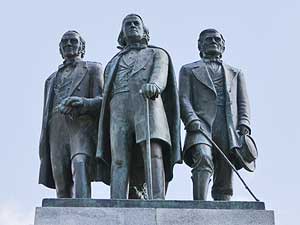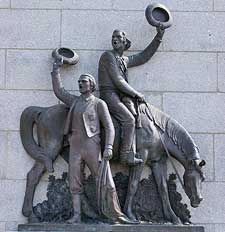
This is the Place Monument
This is the Place stands as a monument to the dedication and sacrifices of the Mormon Pioneers who entered the Salt Lake valley on July 22, 1847. The history of this occasion can be summed up by the plaque located in front of the monument.
"This is the Place" Monument, dedicated July 24, 1947, commemorates the arrival of the Mormon Pioneers into the valley of the Great Salt Lake 100 years before, and also the role of others -- Spanish Catholic Fathers, trappers and fur traders, official government explorers and California emigrants, who contributed to the successful founding of an empire in "The Top of the Mountains." Driven from their homes in Missouri and Illinois because of political and religious prejudice, the Mormons began their historic fifteen hundred mile trek from Nauvoo to the Rocky Mountains February 4, 1846, an event that had been prophesied by the Prophet Joseph Smith four years earlier. As early as September 9, 1845, leaders of the Church had determined to found their "Zion" in the valley of the Great Salt Lake. Because of the intense cold and deadly source of cholora, the four hundred mile trek across Iowa in 1846 was the most trying of the entire exodus. These handicaps, together with the furnishing of 500 volunteers - the Mormon Battalion - to fight in the war against Mexico, forced the Saints to halt temporarily on the Missouri River. Winter Quarters was established on the present site of Florence, Nebraska.From this place on April 7, 1847, the pioneer company left for the Rocky Mountains. The train consisted of 143 men, 3 women, 2 children, 72 wagons, 93 horses, 66 oxen, 52 mules, 19 cows and 17 dogs. Seventeen additional members of the Crow and Therkill families, with three wagons who had wintered at the site of modern Pueblo, Colorado, were added at Fort Laramie, and six members of the Mormon Battalion joined them at the crossing of the Green River, making in all a total of 171 souls who came into Great Salt Lake valley, July 22-24, 1847.
Fort Laramie was reached June 1, South Pass, June 27, and Fort Bridger, July 7. On July 13, Orson Pratt was directed to take 23 wagons and 42 men and proceed ahead to determine where the Reed-Donner Trail crossed the mountains. Two days later, Orson Pratt's company discovered the trail which ran southwest for fifteen miles from the present site of Henefer, Utah and then turned west over the mountains. Following this route, Orson Pratt and John Brown ascended Big Mountain, and from its summit, on July 19, saw for the first time the Great Salt Lake.
Two days later Orson Pratt and Erastus Snow proceeded from the foot of Little Mountain, four and one half miles down Emigration Canyon, ascended a hill near the entrance of the valley, and in the words of Orson Pratt "beheld in a moment such an extensive scenery open before us (that) we could not refrain from a shout of joy which almost involuntarily escaped from our lips the moment this glad and lovely scenery was within our view. Although we had only one horse between us, we traversed a circuit of about twelve miles."
On the morning of July 22, a party of nine horseman, headed by Orson Pratt and George A. Smith, rode into the valley for the purpose of locating a place to plant crops. On the same day, Willard Richards led a train of sixty wagons into the valley. Temporary encampment was made seven and one-half miles southwest from the mouth of the canyon. Early next morning permanent encampment was made two miles north on the banks of the south fork of City Creek. On the same day, the waters of City Creek were turned upon the hard, baked soil, thus inaugurating the system of modern, scientific irrigation in America.
Meanwhile, Brigham Young, who had been seriously ill with Mountain Fever, entered the valley on July 24 with the remaining fifteen wagons. Of this historic occasion, Wilford Woodruff, in whose carriage Brigham Young rode, says: "When we came out of the canyon in full view of the valley, I turned the side of my carriage around, open to the west, and President Young arose from his bed and took a survey of the country. While gazing on the scene he was enwrapped in vision for several minutes. When the vision had passed he said, 'This is the right place, drive on!'"
The figures on the west face of the monument (top) are: Brigham Young (center), great Mormon leader, President of the Quorum of Twelve Apostles, second President of the Church of Jesus Christ of Latter-day Saints (1847-1877). First Governor of the Territory of Utah (1850-1857): Heber C. Kimball (north on President Young's right). Prophet, Apostle, great religious leader, friend and advisor of Brigham Young, first counselor to Brigham Young, (1847-1868): Wilford Woodruff (south on President Young's left). Great religious leader, Apostle, fourth president of the Church of Jesus Christ of Latter-day Saints (1889-1898).

From left to right: Heber C. Kimball, Brigham Young, & Wilford Woodruff. [ more ]
The lower group: Orson Pratt (on horse), Apostle, scientist, mathmatician, explorer, journalist: Erastus Snow (standing), Apostle, explorer, colonizer: The two wagon trains: (north wing) first wagon train (July 22), led by Willard Richards (on second horse), noted physician, Apostle, religious leader, second counselor to Brigham Young (1847-1854), secretary of the Provisional State of Deseret: second wagon train (July 24). Brigham Young, sitting in carriage, Wilford Woodruff driving, Heber C. Kimball and Lorenzo Dow Young walking beside carriage. Women are: Clarissa Decker Young (wife of Brigham Young), Ellen Saunders Kimball (wife of Heber C. Kimball) and Harriet Page Wheeler Decker Young (wife of Lorenzo Dow Young). Boys are: Lorenzo Sobieski Young (son of Lorenzo Dow Young by his wife Persis Goodall) and Isaac Perry Decker (son of Harriet Decker). The nine horsemen (north side of monument, reading from left to right): Orson Pratt, Orrin Porter Rockwell, Joseph Matthews, Erastus Snow. (south side of monument, reading from left to right): John Brown, Jesse C. Little, George A. Smith, an unidentified pioneer and John Pack.

Orson Pratt (on horse), and Erastus Snow (standing). [ more ]
